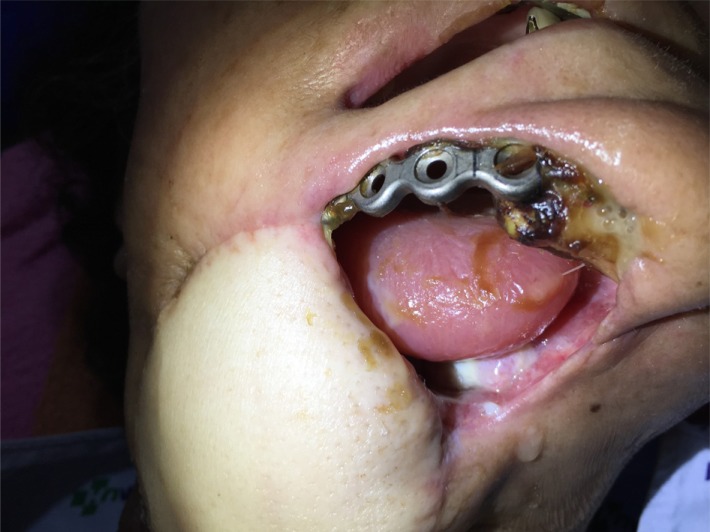J Dent Anesth Pain Med.
2017 Dec;17(4):313-316. 10.17245/jdapm.2017.17.4.313.
Awake intubation in a patient with huge orocutaneous fistula: a case report
- Affiliations
-
- 1Department of Anesthesia and Pain Medicine, Pusan National University Yangsan Hospital, Yangsan, Korea.
- 2Department of Oral and Maxillofacial Surgery, School of Dentistry, Pusan National University, Yangsan, Korea.
- 3Department of Dental Anesthesia and Pain Medicine, Pusan National University Dental Hospital, Dental Research Institute, Yangsan, Korea. kejdream84@naver.com
- KMID: 2399802
- DOI: http://doi.org/10.17245/jdapm.2017.17.4.313
Abstract
- Mask ventilation, the first step in airway management, is a rescue technique when endotracheal intubation fails. Therefore, ordinary airway management for the induction of general anesthesia cannot be conducted in the situation of difficult mask ventilation (DMV). Here, we report a case of awake intubation in a patient with a huge orocutaneous fistula. A 58-year-old woman was scheduled to undergo a wide excision, reconstruction with a reconstruction plate, and supraomohyoid neck dissection on the left side and an anterolateral thigh flap due to a huge orocutaneous fistula that occurred after a previous mandibulectomy and flap surgery. During induction, DMV was predicted, and we planned an awake intubation. The patient was sedated with dexmedetomidine and remifentanil. She was intubated with a nasotracheal tube using a video laryngoscope, and spontaneous ventilation was maintained. This case demonstrates that awake intubation using a video laryngoscope can be as good as a fiberoptic scope.
MeSH Terms
Figure
Reference
-
1. Belleville JP, Ward DS, Bloor BC, Maze M. Effects of intravenous dexmedetomidine in humans. I. sedation, ventilation, and metabolic rate. Anesthesiology. 1992; 77:1125–1133. PMID: 1361310.2. Sessler CN, Gosnell MS, Grap MJ, Brophy GM, O'Neal PV, Keane KA, et al. The richmond agitation-sedation scale: Validity and reliability in adult intensive care unit patients. Am J Respir Crit Care Med. 2002; 166:1338–1344. PMID: 12421743.3. Han R, Tremper KK, Kheterpal S, O'Reilly M. Grading scale for mask ventilation. Anesthesiology. 2004; 101:267. PMID: 15220820.
Article4. Cook TM, Woodall N, Frerk C, Fourth National. Major complications of airway management in the UK: Results of the fourth national audit project of the royal college of anaesthetists and the difficult airway society. part 1: Anaesthesia. Br J Anaesth. 2011; 106:617–631. PMID: 21447488.5. Stackhouse RA. Fiberoptic airway management. Anesthesiol Clin North America. 2002; 20:933–951. PMID: 12512270.
Article6. David L, Mark S. Awake intubation. Contin Educ Anaesth Crit Care Pain. 2015; 15:64–67.7. Yumul R, Elvir-Lazo OL, White PF, Durra O, Ternian A, Tamman R, et al. Comparison of the C-MAC video laryngoscope to a flexible fiberoptic scope for intubation with cervical spine immobilization. J Clin Anesth. 2016; 31:46–52. PMID: 27185677.
Article8. Shirgoska B, Netkovski J. New techniques and devices for difficult airway management. Acta Clin Croat. 2012; 51:457–461. PMID: 23330414.9. Henderson JJ, Popat MT, Latto IP, Pearce AC. Difficult Airway Society. Difficult airway society guidelines for management of the unanticipated difficult intubation. Anaesthesia. 2004; 59:675–694. PMID: 15200543.10. American Society of Anesthesiologists Task Force on Management of the Difficult Airway. Practice guidelines for management of the difficult airway: An updated report by the american society of anesthesiologists task force on management of the difficult airway. Anesthesiology. 2003; 98:1269–1277. PMID: 12717151.
- Full Text Links
- Actions
-
Cited
- CITED
-
- Close
- Share
- Similar articles
-
- Orocutaneous Fistula after Implant Placement with Sinus Floor Elevation via Transalveolar Approach: A Case Report
- Multiple foreign bodies causing an orocutaneous fistula of the cheek
- Successful airway management with combined use of McGrath® MAC video laryngoscope and fiberoptic bronchoscope in a severe obese patient with huge goiter: a case report
- Orocutaneous fistulas of odontogenic origin presenting as a recurrent pyogenic granuloma
- Intermaxillary Fixation under Oral Intubation in a Patient with Le Fort I Fracture: a Case Report


